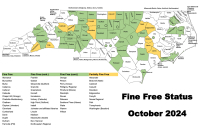Canton Mill pursues new pollution permit
Evergreen Packaging, a large paper mill in Canton, is seeking a new water pollution permit for the Pigeon River.
The paper mill sucks roughly 29 million gallons a day out of the river and uses it in myriad aspects of the paper making process — from cooling coal-fired boilers to flushing chemicals through wood pulp — and then dumps it back in the river again.
The river downstream from the mill is far cleaner today than anytime in the mill’s 100-year history. The Pigeon River was once so polluted few fish species could survive and it was unsafe for people to swim in.
During the 1990s, the mill embarked on a $300 million environmental overhaul, spurred partly by expensive lawsuits.
Environmentalists and downstream communities want the mill to make further improvements. But instead, it seems progress has plateaued.
“While the river has gotten cleaner since the 1980s, we can’t allow North Carolina to end the river cleanup until it’s clean and free of odor, foam and significant toxic discharges,” said Chris Carswell, who lives downstream of the mill in Cocke County, Tenn.
Related Items
But Derric Brown, the director of sustainability for Evergreen, said progress going forward will be measured in much smaller steps than the progress of the past, mostly because of the giant steps already made.
“Incremental improvement is becoming increasingly difficult,” Brown said.
Sergei Chernikov, an environmental engineer in charge of the state permit, said it will take exponentially more effort to make less noticeable improvements as time goes on.
“The law of diminishing returns is in full force,” Chernikov said. “What they are working on now is the remaining 10 percent. It is definitely getting harder with each step. But they are making progress.”
The biggest environmental victory of the 1990s was getting the mill to drastically reduce dioxin, the most toxic chemical discharged into the river. The final health advisory against eating fish caught downstream of the mill was lifted in 2005. Fish once wiped out by the mill’s pollution are being reintroduced in a joint effort between the mill and state wildlife and environmental agencies.
Chernikov called Evergreen the cleanest paper mill in the state and among the cleanest in the world.
“If you look at other facilities throughout the nation and Canada, (Evergreen is) doing much better,” Chernikov said.
Hope Taylor, executive director of Clean Water for NC, disputes that claim, however.
“There is no way this can be called the cleanest paper mill in the world,” Taylor said.
Taylor said the pollution from the mill is all relative to the size of the Pigeon.
“You put an enormous paper mill on a tiny river, it is still a huge amount of pollution being released into a tiny river,” Taylor said.
The mill has faced repeated lawsuits, including class action claims, from downstream landowners in Tennessee over the past two decades. A federal lawsuit by three local landowners from Haywood County was filed this fall, claiming the pollution deprives them of the right to enjoy their property along the river.
The mill’s current pollution permit, dating back to 2001, sets limits on the pollution and mandates water testing on a daily and weekly basis to ensure compliance. The permit expired in 2006. The mill has been operating under an extension while drafting a new permit, which is now up for review.
The mill is operating within state pollution limits on most counts. The current permit allows a variance in two areas: temperature and water color. In the new permit, the mill is again seeking a variance for temperature, but feels a variance for color is no longer necessary.
Temperature
A major source of contention is steaming water released by the mill into the river, which raises the overall water temperature.
In September 2008, for example, the water taken out the river was 66 degrees on average, but was a piping 93.5 degrees when put back in the river. Even half a mile downstream of the mill, the river was still 11 degrees hotter than it should have been — with a temperature of 66 degrees upstream of the mill compared to 77 degrees downstream.
In the winter, the temperature variance is even more acute, with the discharge twice as hot as the river’s natural state.
“You can actually see the river steaming in the winter,” Taylor said.
The discharges exceed federal and state temperature standards by a long shot, which cap the overall temperature increase at 5 degrees. The mill is allowed to raise the river’s temperature by 25 degrees under the variance in the pollution permit.
Chernikov said the river is hotter for only a short section, however, since side streams are constantly flowing into the river and cooling it back down.
“There will be some impact but whether it is significant or measurable is the question,” Chernikov said.
Brown said the temperature is not hurting water quality.
“There have been studies of the river showing that temperatures is not inhibiting the balance in indigenous populations of fish,” Brown said.
Evergreen uses a massive amount of water to cool its equipment and coal-fired boilers, which make electricity for the mill’s operations. It’s cheaper for the mill to make its own power from coal than to buy it.
Chernikov said the variance for Evergreen is similar to that of power plants in the state. In order to cool the water down before returning it to the river, it would require the costly construction of cooling towers. Cooling towers have a downside as well. They lead to lots of evaporation and less water is returned to the river, decreasing its natural flow, he said.
Color
The upgrades of the ‘90s also reduced the discharge of color, which darkens the river. While marked improvements were made to reduce color, the mill has still required a pollution variance for the color of its emissions.
The new permit would make small improvements in color, eliminating the need for a variance, according to the mill and state environmental officials.
Typically, the lack of a variance is a good sign, indicating the mill is meeting state standards. But that’s not necessarily the case with color, Taylor.
Regulating color discharge is a tricky proposition for the state under its current protocol. The state doesn’t have a hard and fast limit, but instead limits color to an “acceptable” level.
“The color is psychological. For some people it may look fine, for some people it may not,” Chernikov said. “The color is really a very subjective parameter.”
Taylor said the mill agreed to make what she considers undetectable changes to its color discharge and in exchange the state suddenly deeming it within the “acceptable” range — thus no longer requiring a variance.
“They are trying to PR their way out of this variance,” Taylor said. “They are cooking the books to make it sound like they have improved in the past decade but they have not.”
Taylor wants the state to adopt a numerical standard for color.
“Without a numerical color standard, there is no way to tell whether they have met an acceptable color standard,” Taylor said.
But Brown said the subjective measure is appropriate.
“Color is aesthetic,” Brown said. “Different people perceive color differently.”
What’s acceptable in the mountains, where rivers are much clearer, could be much different than what’s acceptable along the coast, where rivers are sometimes black and briny by nature. Taylor said the state could still set numerical standards, however, by using a sliding scale based on the natural color of the river compared to the discharge.
Brown said the color discharged by the mill has no environmental impacts but is purely an aesthetic issue.
Taylor disagrees.
“We say color is an indicator of an adverse chemical soup that includes some toxins,” Taylor said. The less color, the less the overall discharge, and the better off the river is in general, she said.
Water gets tainted with color when flushed over wood fibers. Color leaches out of the pulp and ends up in the discharge that goes back into the river.
The mill proposes to reduce color over the next four years from 42,000 pounds a day allowed under the current permit to 39,000 pounds a day, a step the mill has already achieved. The mill’s goal is to reduce color to 37,000 pounds a day within four years. The improvement is small in comparison to the major reductions made since the late 1980s, when the mill discharged 380,000 pounds of color a day.
Taylor is also dismayed that water would be sampled and monitored less frequently under the new permit. Evergreen does the monitoring itself and submits the stats to state regulators. But Taylor wants testing by an independent third party to spot check the mill’s data.
“This mill has been so controversial for so long it is time for there to be independent testing,” Taylor said, calling for “full transparency.”
Dirty water
An environmental advocacy group Environment North Carolina has just issued a report that analyzes industrial pollution of waterways based on monitoring data from the Environmental Protection Agency in 2007. The report is titled Wasting our Waterways: Industrial Toxic Pollution and the Unfulfilled Promise of the Clean Water Act.
Major findings of the report include:
Blue Ridge Paper Products released 123,856 pounds of toxic chemical waste into the Pigeon River and was the 10th largest reported polluter of toxic chemicals in North Carolina in 2007.
The Pigeon River is ranked 7th in North Carolina for most cancer-causing chemicals, with 10,740 pounds of chemicals linked to cancer discharged by the Blue Ridge Paper Products plant in 2007.
Want to weigh in?
A public hearing on a water pollution permit for the Pigeon River by Evergreen Packaging will be held on Tuesday, Jan. 26, at Tuscola High School in Waynesville.
For more information on how to comment or about the draft permit, go to h2o.enr.state.nc.us/NPDES/documents/BRPPPublicHearing.pdf.









